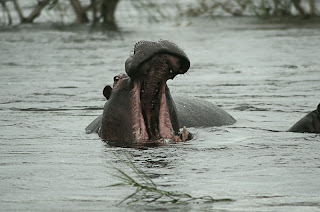Hippopotamus, the name itself is not one to engender fear.
However, hippos cause more deaths in Africa than any other animal. Surprising
given that the hippo is an herbivore. It’s not just that people don’t realize
how dangerous they are, it is also because they are so much more aggressive and
agile than people realize. Looking at them, you think they are just a big, fat,
slow animal. In fact, they can run much faster than humans and are especially
dangerous when they are in the water. Their speed has been estimated at between
18 and 30 mph.


Most or our sightings were hippos in the water, where they
spend most of their time during the day. Their skin is ultrasensitive to sun.
Too much time in the sun and they are sunburned with cracked skin much like
what you see on dry lakebeds. Of course it is worse for the hippos since the
cracks bring sores that are difficult to heal. Fortunately, they do naturally secrete
a salve that medical researchers think might be used by humans as a healing
salve.
 |
| Cattle egrets like hippos. |
We saw a few hippos at Zulu Nyala. The family was safely
watered down in a small pond the first time we saw them only allowing us a
limited view of their eyes. The next time we saw them the pond had increased in
size tenfold after the typhoon blew through dumping several inches of rain as
it did.
 |
| Why we are careful walking to our tents. While they gather together in the water, they tend to feed alone at night. |
Our next view was quick. We were on a short 5-minute ride
from the road to our first camp in Zambia. The ‘skipper’ wanted to get us to
the camp and knew we would get many more views. That evening we went on our
first boat safari and did see several more although the first one was only a
quick glimpse. The guide explained that he had seen a baby somewhat separated
from its mother and was concerned for our safety. Better safe than sorry.
Over the next several days we would see many hippos in the
water. On a couple of occasions, we saw bloats of 25 or more. Our guides were
cautious about getting too close and only on a couple of occasions did we see
their ‘you are getting too close’ behavior of opening the mouth to show us
their dangerous teeth. Usually we were just able to watch them slowly rise to
breathe and then retreat beneath the water.
The most interesting views were those few we had of the
hippos on land. We were able to get much closer on land. For some reason,
hippos are much less aggressive on land. Perhaps this is because they really
only eat while on land. Just about every other part of their lives is conducted
in the water from procreation to defecation.
 |
| A group of hippos is called a bloat. This is a small one. |
On land we could clearly see the effects that the sun has on
their skin. The pictures tell the story better than I can, but notice the
numerous scars and open sores.
Finally, an interesting story from Wikipedia - my favorite
source of information. ;-(
It seems that Pablo Escobar of Colombian cartel fame had a bloat
of four that he bought from a zoo in New Orleans. After Escobar was captured,
no one wanted to deal with the hippos, so they expanded the size of the bloat
to 16. In 2009, two escaped and caused
so much havoc among the farmers that one was killed by hunters. That is the end
of the Wikipedia story, so we don’t know what happens next, but perhaps one day
hippos will be one of the sites we expect to see on visits to South America.
Seriously, I hope not, but it does show us again the havoc we humans can create
for our environment when we try to play god.
 |
| Greetings for us as we arrive at Tubu Tree Camp |































































